Dr.Teruo Higa’s
Living A Dream
- 2025
- Sep:#209 The Widespread Use of EM in Ecuador
- Sep:#208 The Widespread Use of EM in Chile
- Jul:#207 Peru, where EM has taken root throughout the country
- May:#206 EM Application Technology in Paraguay Begins to Evolve into Advanced Circular Agriculture
- May:#205 Practical Application of Soil Disinfectant-Free Cultivation Using EM Technology
- Apr:#204 How EM Use Has Spread Throughout the Philippines
- Mar:#203 How to Use EM to Fundamentally Solve the Problem of Agricultural Residue Burning
- Feb:#202 The Spread of EM technology in Germany
- Jan:#201 The 2nd Ichiro Masaki Memorial Universal Village EM International Conference
- Jan:#200 Cleanup of the Ala Wai Canal in Hawaii, where social bonds are strengthened using EM
- 2024
- Nov:#199 EM trials in India with bananas, tomatoes, and pomegranates
- Oct:#198 The Steadily Evolving EM Nature Farming Method at the Blue Sky Palace - Part 8
- Sep:#197 The Steadily Evolving EM Nature Farming Method at the Blue Sky Palace - Part 7
- Aug:#196 The Steadily Evolving EM Nature Farming Method at the Blue Sky Palace - Part 6
- Jul:#195 The Steadily Evolving EM Nature Farming Method at the Blue Sky Palace - Part 5
- Jun:#194 Steadily Evolving EM Nature Farming Method at the Blue Sky Palace - Part 4
- May:#193 Steadily Evolving EM Nature Farming Method at the Blue Sky Palace - Part 3
- May:#192 Steadily Evolving EM Nature Farming Method at the Blue Sky Palace - Part 2
- Apr:#191 Steadily Evolving EM Nature Farming Method at the Blue Sky Palace
- Mar:#190 Quantum Mechanical Effects of EM Gravitron Charcoal
- Mar:#189 The barrier space in Okinawa (Ryukyu Islands) has risen to another dimension
- Jan:#188 Sixty Days after Typhoon No.6
- 2023
- Oct:#187 Supermassive Typhoon No.6 and Subsequent Typhoon No. 11
- Sep:#186 Massive Typhoon No.6 that swallowed the Ryukyu Islands Graviton barrier
- Sep:#185 August 8th is World “EM Mudball Day”
- Aug:#184 A disease-free life depends on the health of the intestinal microbiome.
- Jul:#183 Trial and Error at the Blue-Sky Palace, Part 3
- Jun:#182 Trial and Error at the Blue-Sky Palace, Part 2
- Apr:#181 Trial and Error at the Blue-Sky Palace
- Mar:#180 Ala Wai Canal Cleanup Project in Waikiki, Hawaii
- Feb:#179 High-Yield, High-Quality Rice Production Using EM
- Feb:#178 The Progress the "Soil Preparation Workshop" of the Oishi 3-chan Club (Part 2)
- Jan:#177 Organic Farming Instructional Manual Using EM
- 2022
- Nov:#176 The Typhoon Situation in Okinawa in 2022
- Sep:#175 Third-Party Verification of the Graviton barrier in Okinawa Part-2
- Sep:#174 Third-Party Verification of the Graviton barrier in Okinawa
- Aug:#173 Ecosystem Changes Observed in Okinawa in 2021 Part-5
- Jun:#172 Ecosystem Changes Observed in Okinawa in 2021 Part-4
- May:#171 Ecosystem Changes Observed in Okinawa in 2021 Part-3
- Apr:#170 Ecosystem Changes Observed in Okinawa in 2021 Part-2
- Mar:#169 Koizumi Farm in Kamakura Continues to Evolve
- Feb:#168 Ecosystem Changes Observed in Okinawa in 2021 Part-1
- 2021
- Dec:#167 Enjoying EM Technology While Enriching the Local Ecosystem
- Nov:#166 A Case Study of the Use of EM in a Next Generation Free School in Tune with the Cycles of Nature
- Oct:#165 Typhoon conditions and flowers in Okinawa from August to October
- Sep:#164 Re-learning the origins of river purification using EM Cleaning up the Dairyuji River in Senami (Murakami City, Niigata Prefecture)
- Aug:#163 Measures Against Natural Disasters and Re-learning the Starting Point of EM
- Jul:#162 Summary of FFC (Foods for Children) Okinawa Forum 2021
- Jun:#161 Restoring the Vigor of an Old Tree and Purifying the Environment with EM Technology That Even an Amateur Can Do
- May:#160 The Public is Beginning to Recognize the Use of EM Smokeless Carbonizers
- Apr:#159 EM Hado (EM Graviton) that exerts quantum superposition effect over time
- Mar:#158 Virus-free Okinawan Plants Through Use of an EM Graviton Barrier
- Jan:#157 Enjoyable Farming for Self-Sufficiency that Even Amateurs Can Do
- 2020
- Dec:#156 EM quantum energy effect occurring in Okinawa
- Nov:#155 Implementing EM graviton farming as a flood countermeasure for apple orchards
- Oct:#154 The Latest Book on the Practical Uses of EM "You Are the One Who Draws Out the Power of Microorganisms," by Chizuko Nomoto
- Sep:#153 Application of EM technology to long periods of rain, lack of sunshine, storms, heavy rains, etc.
- Aug:#152 EM application in Kitanakagusuku village plant waste recycling yard
- Jul:#151 Natural Disaster Countermeasures Using EM Technology: Part 2
- Jul:#150 Natural Disaster Countermeasures Using EM Technology
- May:#149 How to make your home and workplace an energy spot by living a complete EM lifestyle: creating the ultimate source of health and environmental purification
- Apr:#148 EM, Viruses and the Pandemic
- Apr:#147 New agriculture applying quantum mechanics Part 2
- Apr:#146 New agriculture applying quantum mechanics
- Apr:#145 Wonderful EM Miracle
- 2019
- Nov:#144 The movie “Revival II” and the reality of Fukushima
- Oct:#143 Boundary dome and foliar spraying of EM・X GOLD and EM 3
- Oct:#142 Kirakira (Sparkling) Summer Vegetable Festa in 2019
- Aug:#141 Excessive salt inevitably causes salt damage
- Jul:#140 Diverse applications of charcoal Part 3
- Jun:#139 Diverse applications of charcoal Part 2
- Jun:#138 Diverse applications of charcoal
- Jun:#137 Purification power of salt
- May:#136 The degree of soil contamination is a reflection of the microflora
- May:#135 Definitive use of EM barriers to deal with typhoons
- May:#134 Implementing authentic Nature Farming
- May:#133 How to enhance healthy Hado (wave energy) by EM
- May:#132 Eating Dirt (Soil)
- May:#131 Hado (Wave energy) involved in health
- May:#130 Reaffirming EM technology to realize the essence of agriculture
- May:#129 The 2nd EM Producer Networking Meeting
- Apr:#128 Understanding the application of seawater and salt in crop cultivation
- Apr:#127 Prevention of Disasters by EM Technology
- Mar:#126 Quantum overlay effective utilization of EM
- Jan:#125 EM Disaster Recovery Support Projects in 2017
- 2018
- 2017
- Aug:#121 Escape from conventional agricultural traps
- Jul:#120 Limitation and important caveats regarding utilization of salt
- Jun:#119 EM Technology to Break Through the Limits of Pesticide-Free Strawberries
- May:#118 Application of barriers using EM rectification force
- Apr:#117 The 1st EM Produce Growers' Networking Conference
- Mar:#116 Sumizo kun: The Ultimate Versatile Carbonization Equipment
- Feb:#115 How to make and use simple carbonized and rectified ash
- Jan:#114 Achievements of 2016
- 2016
- Dec:#113 Definitive Measures Against Typhoons
- Nov:#112 International Conference on Universal Village
- Oct:#111 90% of Your Body is Microbes
- Sep:#110 Disaster Countermeasures Using EM
- Aug:#109: Changes in the Natural Environment by EM Barrier Domes in Okinawa
- Jul:#108: Multi-purpose Utilization of Activated EM with Seawater and Salt
- Jun:#107: Marine Day, when EM Mudballs and Activated EM are Applied Throughout Japan
- May:#106: The Function of EM and Gravitational Waves–Part 3
- Apr:#105: The Function of EM and Gravitational Waves–Part 2
- Feb:#104: The Function of EM and Gravitational Waves
- Feb:#103: The Importance of Phototrophic Bacteria in EM
- 2015
- Dec:#102: Results of Environmental Forum "Utsukushima EM Paradise" 2015
- Nov:#101: Environmental Forum "Utsukushima EM Paradise" 2015
- Oct:#100: A New Phase of Limit Breakthrough Using EM
- Sep:#99: A New Phase of Limit Breakthrough through EM
- Aug:#98: The Tokyo Bay Area Began Creating a Truly Livable Hometown
- Jul:#97: Rectifying Effects of EM
- Jun:#96: Lake Suwa Sousei lecture
- May:#95: In Order to Further Ensure Limit Breakthrough
- Apr:#94: Theatrical Release of the Documentary Film SOSEI-Revival to Enlighten People on the New Possibilities of Microorganisms
- Mar:#93: What Underlies Limit Breakthrough (Part 2)
- Feb:#92: EM Functions to Break Through Limits
- Jan:#91: At the Start of 2015
- 2014
- Dec:#90: Looking Back at 2014
- Nov:#89: Shikoku EM FESTA 2014, Virtuous Circle Conference in Matsuyama, Ehime Prefecture
- Oct:#88: Using EM to Deal with Weather Disasters (Part 2)
- Sep:#87: Current Status of Radioactivity Measures Using EM in Fukushima
- Aug:#86: APNAN (Asia Pacific Natural Agriculture Network) 25th Anniversary Conference in 2014
- Jul:#85: Using EM to Deal with Weather Disasters
- Jun:#84: Substantial Improvement of Soil
- May:#83: The Energy Rectification Force of EM
- Apr:#82: The Annual 18th EM Technology Exchange Meeting and Tohoku Conference in Shichigahama
- Mar:#81: Salmon going upstream in Kitaura (Kasumigaura)
- Feb:#80: The Microbiome Again
- Jan:#79: Inauguration of the Federation of Diet Members Who Use and Apply Effective Microorganisms
- 2013
- Dec:#78: Receiving an Honorary Doctoral Degree from Rajamangala University of Technology in Thailand
- Nov:#77: The Use of EM in School Education in Bhutan
- Oct:#76: Well of Bonding
- Sep:#75: The Background to EM Not Being Employed by Public Institutions to Deal with Radiation
- Aug:#74: Dealing with Disaster: Using EM in Crisis Management
- Jul:#73: EM Events on Ocean Day
- Jun:#72: Using EM to Deal With Heat Stroke and Summer Heat Fatigue
- May:#71: An EM Model Town in Malaysia
- Apr:#70: Steps the Japanese Government is Taking to Deal with Radiation: Are They Really Safe?
- Mar:#69: EM Group Disaster Reconstruction Aid Project in Fukushima
- Feb:#68: EM and Microbiomes (Microbial Flora)
- Jan:#67: A Necessary Evil is Still Evil
- 2012
- Dec:#66: The 17th National EM Technology Exchange Conference / Hokkaido Conference in Sapporo
- Nov:#65: EM Forum 2012 in Okinawa and the Environmental Forum in Fukushima
- Oct:#64: 2012 EM Forum
- Sep:#63: A New Earth Saving Revolution
- Aug:#62: The Asahi Newspaper’s Misguided Reports About EM
- Jul:#61: Using EM in Radioactive Contamination Measures in Fukushima Prefecture
- Jun:#60: The Effects of Using EM to Inhibit the Absorption of Radioactivity as Confirmed in Fukushima
- May:#59: Recovery Support for the Great East Japan Earthquake
- Apr:#58: The Royal Kingdom of Thailand, in which EM Functions as a Set Government Policy
- Mar:#57: Report on the Measures Taken by Kingdom of Thailand Using EM to Deal with Polluted Water
- Feb:#56 EM™ as Part of National Policy in Thailand to Deal with Sanitation Issues Resulting from the Flood of 2011
- Jan:#55 The Law of Syntropy (Revitalization)
- 2011
- Dec:#54 EM Forum 2011
- Nov:#53 Shikoku EM Festa 2011- Zenjunkan no Wa (Virtuous Circle) Tokushima Conference in Naruto -
- Oct:#52 The Mystery of Interim Safety Values for Radioactive Material
- Sep:#51 Successful Radiation Countermeasures Using EM
- Aug:#50 Events on Sea Day in which EM Mud Balls are Thrown into the Water and Activated EM is Applied.
- May:#47 Dealing with the Damage Caused by the Eastern Japan Earthquake
- Apr:#46 Eastern Japan Earthquake
- Mar:#45 The 16th National EM Technology Hokuriku Conference in Fukui
- Feb:#44 More Thoughts on Avian Influenza and Foot-and-Mouth Disease
- Jan:#43 Happy New Year!
- 2010
- Dec:#42 Shikoku EM FESTA 2010・Zenjunkan no wa (Virtuous Circle) Fellowship Conference in Tobe, Ehime Prefecture
- Nov:#41 EM Forum 2010
- Oct:#40: My Thanks to the EM™ Volunteers Who Helped in the Fight Against Foot-and-Mouth Disease in Miyazaki Prefecture
- Sep:#39 International EM Mud Ball Day
- Jul:#37 Poland EM Forum 2010
- Jun:#36 EM Countermeasures Against Foot-and-Mouth Disease
- May:#35 Abnormal Weather
- Apr:#34 EM Activities in Thailand: Finding Solutions to the Challenges Facing the Nation
- Mar:#33 New Developments in the Evolution of EMTM in Thailand
- Feb:#32 Results Starting to Be Seen at the Mikasa Project
- Jan:#31 Towards an EM-Use Society
- 2009
- Dec:#30 EM Summit
- Nov:#29 The System in Penang State in Malaysia that Made the World EMTM Mudball Day a Success
- Oct:#28 The "World EM Mudball Day" in Malaysia
- Sep:#27 Validating EMTM Medicine: Case Study Reports from EM Users 2009. (Part 3)
- Sep:#26 Validating EMTM Medicine: Case Study Reports from EMTM Users 2009. (Part 2)
- Jul:#25 Validating EMTM Medicine: Case Study Reports from EMTM Users 2009. (Part 1)
- Jun:#24 Activities to Disseminate EM-Focused Nature Farming in China
- May:#23 Use of EMTM in Response to Swine Flu
- Apr:#22 Using EM to Solve Public Administrative Costs
- Mar:#21 Reaffirming the Versatility of EM
- Jan:#20 The Beginning of a New Era
- 2008
#161 Restoring the Vigor of an Old Tree and Purifying the Environment with EM Technology That Even an Amateur Can Do

When the Fukuryu pine tree at Wakoan in Kyoto began to weaken, U-net (United Networks for Earth Environment), board member Mr. A, who lives in Kyoto, sprayed activated EM and applied EM ceramics powder to the trunk to give it a respite.
Restoring the vigor of a weakened pine tree is one of the most difficult tasks in the landscaping industry. Even if you implement various methods that seem to be the best, in the end you leave the rest up to God or luck, and there is no absolute method for restoring the tree to good health.
On January 4th, Mr. B from the Kyowa Cultural Association in Wakoan asked me to comment on the landscaping company’s estimate of cost and its proposed implementation method for restoring the Fukuryu pine tree.
What they proposed was a sensible soil improvement method, but there is no guarantee at all that the tree would recover through this method. I was determined to get good results if someone involved in EM was involved, and I asked Mr. A to help us in order to be able to apply the latest EM technology.
Below are comments from Mr. B on emergency measures for the Fukuryu pine tree and the guidelines I taught Mr. A. This method does not require soil improvement and is easy for anyone to implement.
Restoring the vigor of a weakened pine tree is one of the most difficult tasks in the landscaping industry. Even if you implement various methods that seem to be the best, in the end you leave the rest up to God or luck, and there is no absolute method for restoring the tree to good health.
On January 4th, Mr. B from the Kyowa Cultural Association in Wakoan asked me to comment on the landscaping company’s estimate of cost and its proposed implementation method for restoring the Fukuryu pine tree.
What they proposed was a sensible soil improvement method, but there is no guarantee at all that the tree would recover through this method. I was determined to get good results if someone involved in EM was involved, and I asked Mr. A to help us in order to be able to apply the latest EM technology.
Below are comments from Mr. B on emergency measures for the Fukuryu pine tree and the guidelines I taught Mr. A. This method does not require soil improvement and is easy for anyone to implement.
In response to Mr. B’s Fax dated January 4th regarding the restoration of pine tree vigor, Dr. Higa is provided three bottles of EM・X GOLD, which we are sending to you.
The comments from Dr. Higa and the use of EM for the recovery of tree vigor are as follows.
Comments:
When pine trees start to weaken, it is almost impossible to restore them using conventional methods, but as an emergency measure, I offer EM・X GOLD with enhanced hado for pine trees.
As for EM, you can use activated EM as long as it contains salt, but if you want to make a manual in the future, please use EM・1 from our authorized distributor in your area.
EM can be applied even in winter, so please apply EM・X GOLD to the pine tree as soon as possible. As I wrote on the box, apply once a month for a total of three months. Also prepare EM kekkai (barrier) blocks and place them at the four corners around the pine tree outside where EM・X GOLD is applied. The barrier blocks should be buried at a depth of 20-30cm.
How to use EM:
EM・X GOLD should be used in a 1:1,000 dilution, and EM・1 should be used in a 1:500 dilution.
[Example] Apply 100 liters of diluted water every week, mainly at the roots of the pine trees.
Monthly usage:
• Water: 100 liters x 4 times = 400 liters
• EM・X GOLD: 125ml x 4 times=500ml (one plastic bottle)
• EM・1: 200ml x 4 times=800ml
That’s all you need to do. If you have any questions, please contact me.
Thank you for your cooperation.
The comments from Dr. Higa and the use of EM for the recovery of tree vigor are as follows.
Comments:
When pine trees start to weaken, it is almost impossible to restore them using conventional methods, but as an emergency measure, I offer EM・X GOLD with enhanced hado for pine trees.
As for EM, you can use activated EM as long as it contains salt, but if you want to make a manual in the future, please use EM・1 from our authorized distributor in your area.
EM can be applied even in winter, so please apply EM・X GOLD to the pine tree as soon as possible. As I wrote on the box, apply once a month for a total of three months. Also prepare EM kekkai (barrier) blocks and place them at the four corners around the pine tree outside where EM・X GOLD is applied. The barrier blocks should be buried at a depth of 20-30cm.
How to use EM:
EM・X GOLD should be used in a 1:1,000 dilution, and EM・1 should be used in a 1:500 dilution.
[Example] Apply 100 liters of diluted water every week, mainly at the roots of the pine trees.
| Water | EM・X GOLD | EM・1 |
| 100 liters | 125ml | 200ml |
Monthly usage:
• Water: 100 liters x 4 times = 400 liters
• EM・X GOLD: 125ml x 4 times=500ml (one plastic bottle)
• EM・1: 200ml x 4 times=800ml
That’s all you need to do. If you have any questions, please contact me.
Thank you for your cooperation.
Secretary’s Office,
EM Research Organization
EM Research Organization
Dear Mr. A,
Mr. B sent me a report on the Fukuryu pine, and a book. I sent him my book, The Essence of Japan and a separate message to help him understand the true characteristics of EM. Kyoto has historically had many impurities in its water supply, and all the shallow underground water (at a depth of 50m depth) is rusty (oxidized) like the Nijo Castle. As you know, it is obvious that this rust can be purified by EM, but we need the cooperation of the government offices to do so.
As for the Fukuryu pine, the Culture Properties Protection Division of Kyoto City has expressed its understanding of its importance, so I hope that the members of the “List of Buildings and Gardens that Add Color to Kyoto” will create an EM kekkai in the same way as at Wakoan, utilize EM, clean and carefully make use of cultural properties for a long time, and develop activities that make the people involved healthy.
If you create EM kekkai (EM barrier ) as is normally done, and spray EM freely on gardens and buildings once or twice a year, everything will have biological information and be revitalized. Old buildings will stop deteriorating and will be revitalized, and at the same time, they will become more resistant to disasters such as earthquakes, typhoons, and torrential rains, and before you know it, the entire city will be surrounded by EM kekkai, and it will be possible to turn it into an energy spot like Okinawa or Fukushima. At the same time, this activity will be historic because it will mark a new activity of U-net conducted in an urban area.
1. Bury EM Kekkai blocks (rectifying blocks) in the four corners of the building. If they cannot be buried, they are also effective placed on the ground. The barrier is effective even at a distance of 100m.
2. Dilute EM・1 to a 1:500-1:1,000 dilution, add EM・X GOLD at 1:10,000 dilution, and spray in the garden, or spray under the floor, walls, roof, etc. as if washing them.
3. If you continue to do 2. once or twice a year, you will see a revitalizing power in proportion to the number of times you spray.
4. In order to strengthen the EM barrier, dilute EM・X GOLD to a 1:500 – 1:1,000 dilution and inject 1 liter per EM kekkai block over the top of the block (if not buried, spray it so that the blocks are thoroughly moistened).
5. If you say a prayer* in praise of EM, the power will be superimposed for that number of times. (The level of contamination varies depending on the area, so keep doing this until you see the desired effects.)
If you have any questions, please contact the secretary’s office and make a simple manual based on your past experience.
*See "The Essence of Japan," p. 131.Mr. B sent me a report on the Fukuryu pine, and a book. I sent him my book, The Essence of Japan and a separate message to help him understand the true characteristics of EM. Kyoto has historically had many impurities in its water supply, and all the shallow underground water (at a depth of 50m depth) is rusty (oxidized) like the Nijo Castle. As you know, it is obvious that this rust can be purified by EM, but we need the cooperation of the government offices to do so.
As for the Fukuryu pine, the Culture Properties Protection Division of Kyoto City has expressed its understanding of its importance, so I hope that the members of the “List of Buildings and Gardens that Add Color to Kyoto” will create an EM kekkai in the same way as at Wakoan, utilize EM, clean and carefully make use of cultural properties for a long time, and develop activities that make the people involved healthy.
If you create EM kekkai (EM barrier ) as is normally done, and spray EM freely on gardens and buildings once or twice a year, everything will have biological information and be revitalized. Old buildings will stop deteriorating and will be revitalized, and at the same time, they will become more resistant to disasters such as earthquakes, typhoons, and torrential rains, and before you know it, the entire city will be surrounded by EM kekkai, and it will be possible to turn it into an energy spot like Okinawa or Fukushima. At the same time, this activity will be historic because it will mark a new activity of U-net conducted in an urban area.
1. Bury EM Kekkai blocks (rectifying blocks) in the four corners of the building. If they cannot be buried, they are also effective placed on the ground. The barrier is effective even at a distance of 100m.
2. Dilute EM・1 to a 1:500-1:1,000 dilution, add EM・X GOLD at 1:10,000 dilution, and spray in the garden, or spray under the floor, walls, roof, etc. as if washing them.
3. If you continue to do 2. once or twice a year, you will see a revitalizing power in proportion to the number of times you spray.
4. In order to strengthen the EM barrier, dilute EM・X GOLD to a 1:500 – 1:1,000 dilution and inject 1 liter per EM kekkai block over the top of the block (if not buried, spray it so that the blocks are thoroughly moistened).
5. If you say a prayer* in praise of EM, the power will be superimposed for that number of times. (The level of contamination varies depending on the area, so keep doing this until you see the desired effects.)
If you have any questions, please contact the secretary’s office and make a simple manual based on your past experience.
Dr. Teruo Higa
Professor Emeritus, University of the Ryukyus
Chairman of the board of directors, United Networks for Earth Environment
Professor Emeritus, University of the Ryukyus
Chairman of the board of directors, United Networks for Earth Environment
In late March, I received the following report from Mr. A.
I would like to report about the tree at Wakoan. When I visited there last week, on March 19th, the pine tree looked much healthier. This pine tree is over 200 years old. A friend of mine who had seen it last fall was worried about it, and when we visited together this time, he was happy to see that it was full of greenery. Thank you very much for your help.
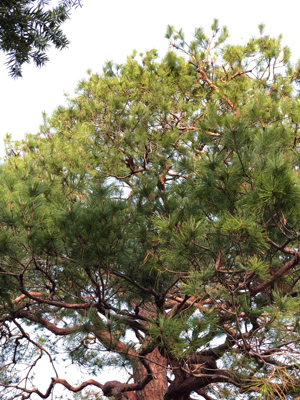
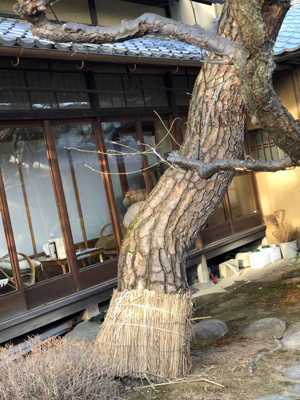

The definitive case of the revival of an old tree by EM technology dates back to 1988. A sacred tree (Confucius tree, over 2500 years old) of the Formosan red cypress in the northern part of the Taiwan mountains (Hualien) had begun to die (see the photo on the left), and I was asked if EM technology could do something about it.
When I consulted a Japanese arborist he told me that it would cost about 2 million yen, but that he could not guarantee the tree’s recovery.
In June 1988, I went to the site and instructed them to dilute EM・X GOLD mixed with EM ceramic powder in a 1:1,000 dilution and spray it repeatedly so that it would soak into the ground around the trunk near the roots, and also to spray 1 liter of activated EM・1 per square meter over the entire soil.
When I consulted a Japanese arborist he told me that it would cost about 2 million yen, but that he could not guarantee the tree’s recovery.
In June 1988, I went to the site and instructed them to dilute EM・X GOLD mixed with EM ceramic powder in a 1:1,000 dilution and spray it repeatedly so that it would soak into the ground around the trunk near the roots, and also to spray 1 liter of activated EM・1 per square meter over the entire soil.
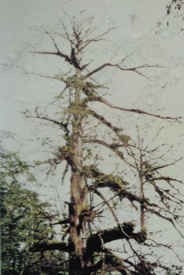
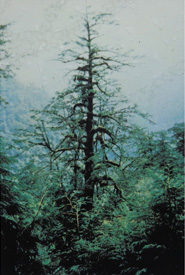
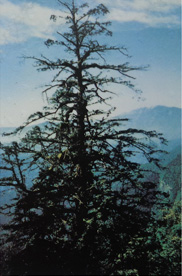
By December, the tree had considerably recovered as shown in the center photo, and a year later, in June 1989, it recovered as shown in the photo on the right, and was able to appear on the cover of the Journal of the Taiwan Forestry Society. After that, it gradually grew even healthier, and just when it seemed like it was only a matter of time, it was unfortunately damaged by several massive typhoons in the 1990s of an intensity they had never experienced before.
This experience is now being used to restore the vigor of old cherry trees in Japan. In addition to the Yamataka Jindaizakura cherry tree, the first nationally designated natural monument in Mukawa town, Hokuto City, Yamanashi Prefecture, the Takizakura cherry tree in Miharu, Fukushima Prefecture, and the rows of cherry trees in Tokyo National Park, the project has spread on a volunteer basis throughout Japan.
The 590 year old cherry tree in Yoshitaka in Inzai City, Chiba Prefecture, shown in the photo, had weakened considerably and was thought to be dying, but it has been greatly revived with the care of those involved in EM activities.
This experience is now being used to restore the vigor of old cherry trees in Japan. In addition to the Yamataka Jindaizakura cherry tree, the first nationally designated natural monument in Mukawa town, Hokuto City, Yamanashi Prefecture, the Takizakura cherry tree in Miharu, Fukushima Prefecture, and the rows of cherry trees in Tokyo National Park, the project has spread on a volunteer basis throughout Japan.
The 590 year old cherry tree in Yoshitaka in Inzai City, Chiba Prefecture, shown in the photo, had weakened considerably and was thought to be dying, but it has been greatly revived with the care of those involved in EM activities.
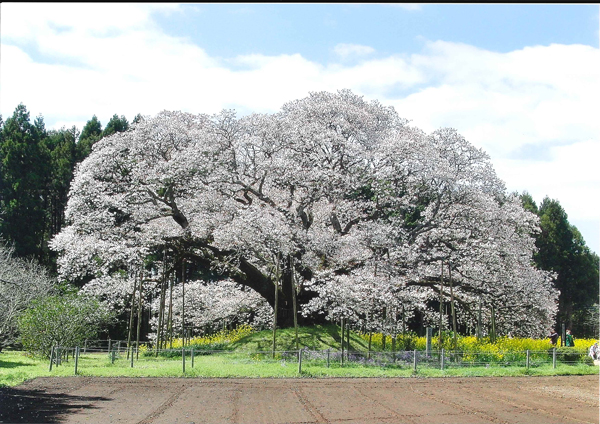
What’s Happening in Okinawa
The change in the path of Typhoon No. 2 is as reported in the local newspaper as of April 20, but since then, it has been bending to the south and changing its course to the southwest side as it approaches main island of Okinawa. Since this is the first time such a phenomenon has been observed, it may be an effect of the EM graviton barrier in Okinawa, but I would like to wait for further observations. As usual, I will introduce some flowers that appeared in our local newspaper.
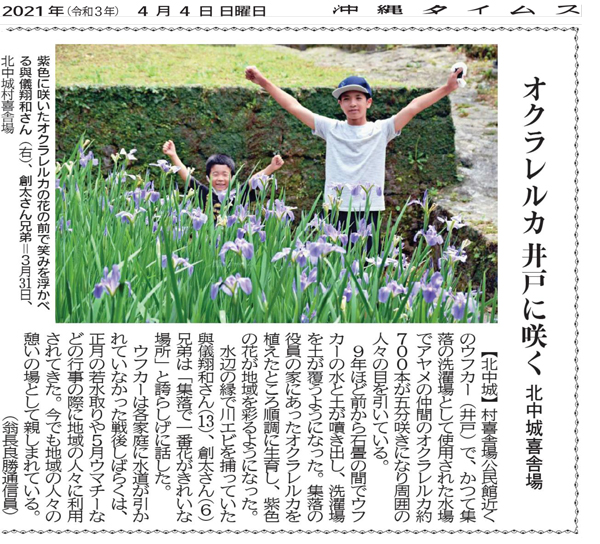
Ochoroleuca blooms in a well at Kitanakagusuku Kishaba
April 4, 2021 (courtesy of Okinawa Times)
At the Ufukar (well), that was once used as a washing place for the village, near the Kishaba Community Center in Kitanakagusuku Village, about 700 Ochoroleuca, Iris Orientalis, are half in bloom and attracting the attention of the people. About nine years ago, water and soil from the Ufukar gushed out between the stone pavement and covered the washing place with soil. They planted Ochoroleuca, which was growing at the house of local official, and it grew well, and the purple flowers became to decorate the area.
Showa Yogi, 13, and Sota, 6, who were catching river shrimps near the Ufukar area, proudly said, “This is the most beautiful flowering place in the village.” For a while after World War II, when water supply was not yet available in every household, Ufukar was used by the local people for events such as the first water drawn from a well on New Year’s Day and the Umachi, the first ears of rice celebration in May. It is still a popular place for local people to relax.
(Reporter,Yoshikatsu Onaga)
Photo: Brothers Showa Yogi, right, and Sota smile in front of the purple flowers of the Ochoroleuca.
March 31, Kishaba, Nakagusuku Village
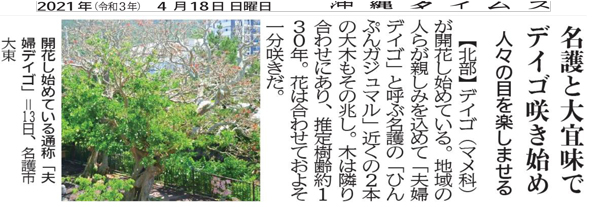
Deigo, Indian coral tree flowers, begin to bloom in Nago City
and Ogimi Village, delighting people
April 18, 2021 (Courtesy of Okinawa Times)
In the northern part of Okinawa, Deigo (Legume Family) are beginning to bloom. Two large Deigo trees near the “Himpun Banyan” in Nago City, which local people affectionately call “husband and wife Deigo,” are also showing signs of blooming. The trees are located next to each other and are estimated to be about 130 years old. They are both just beginning to bloom.
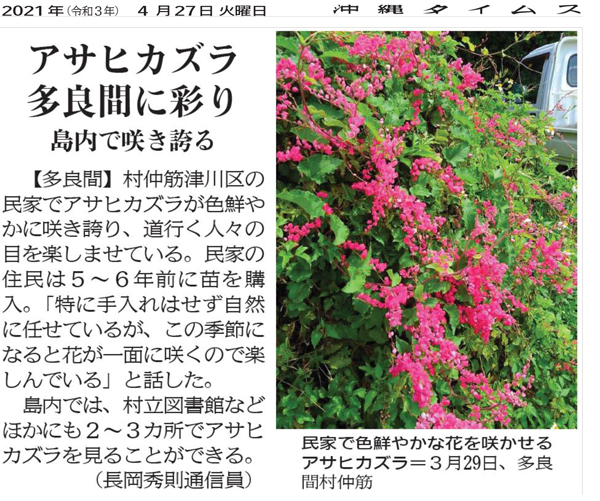
Asahikazura Color the Village of Tarama
Blooming on the islands
April 27, 2021 (Courtesy of Okinawa Times)
Asahikazura, coral vine, are in full bloom at a house in Nakasuji Tsugawa-ku, Tarama Village, and are delighting the eyes of passersby. The residents of the house bought the seedlings five to six years ago. He said, “I don’t take any special care of, and just let nature take its course, but can enjoy it because the flowers bloom all over the place in this season." The coral vine can be seen in two or three other places on the island, including the village library.
(Reported by Hidenori Nagaoka)
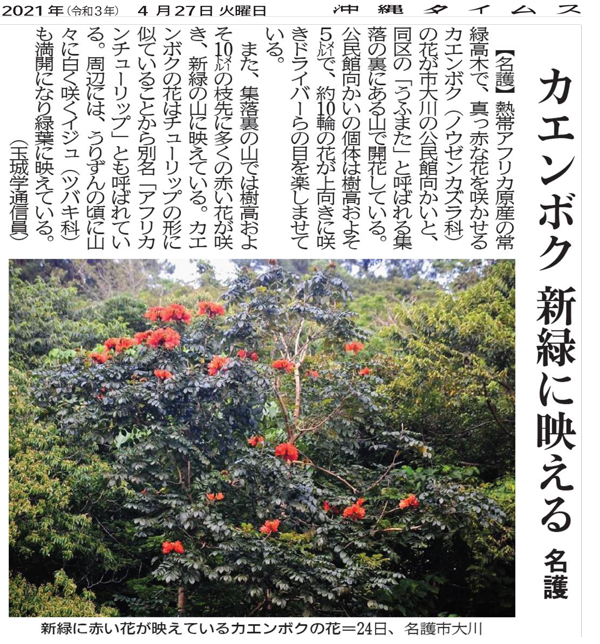
Kaenboku reflected in fresh greenery in Nago City
April 27, 2021 (Courtesy of Okinawa Times)
The bright red flowers of the Kaenboku (family Nymphaeaceae), an evergreen tree that is native to tropical Africa, are blooming across the street from the community center in Okawa, Nago City, and on a mountain behind the village called Ufumata in the same district. The one across from the community center is about 5m tall and has about 10 flowers blooming upward, delighting the eyes of drivers.
In the mountains behind the village, a 10 m tall tree with many red flowers on the tips of its branches looks beautiful against the fresh greenery of the mountains. Because the flowers are shaped like tulips, they are also called "African tulips.” In the vicinity, the ijus (Camellia sinensis), which bloom in the mountains around the time of the Urijin season, are also in full bloom and look beautiful against the green leaves.
(Reported by Manabu Tamaki)
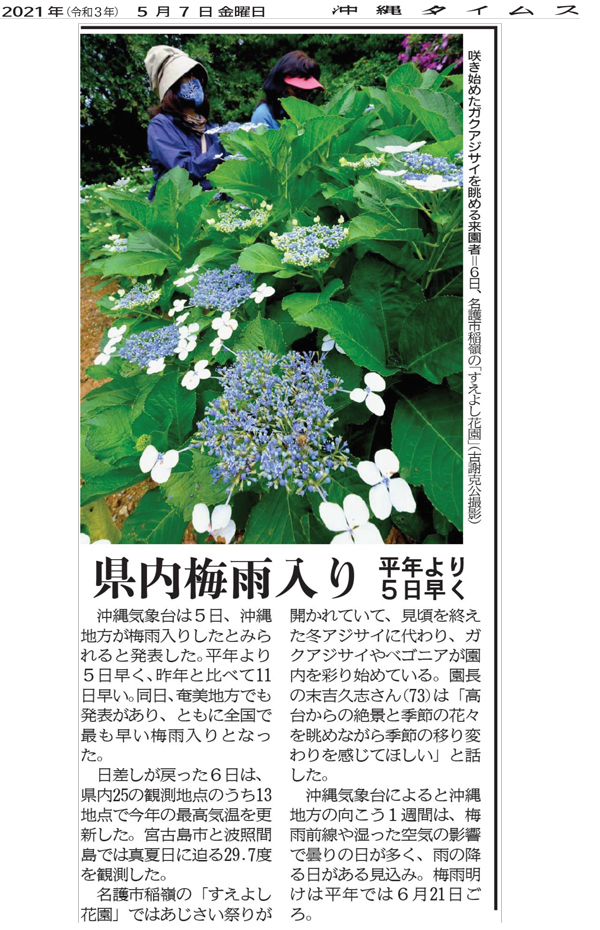
Rainy season begins in Okinawa Prefecture, five days earlier than normal
May 7, 2021 (Courtesy of Okinawa Times)
The Okinawa meteorological observatory announced on the 5th that Tsuyu, the rainy season, seems to have arrived in the Okinawa region, which is five days earlier than usual and 11 days earlier than last year. On the same day, the same announcement was made for the Amami region, making it the earliest rainy season in Japan for both Okinawa and Amami. ¬¬On the 6th, when the sunshine returned, 13 of the 25 observation points in Okinawa Prefecture recorded their highest temperatures of the year. In Miyakojima City and Hateruma Island, the temperature reached 29.7 ℃, close to the temperature of a midsummer day.
At the Sueyoshi Flower Garden in Inamine, Nago City, a hydrangea festival is underway, and the winter hydrangeas that are no longer in full bloom are being replaced by Lacecap hydrangeas and Begonias that are now blossoming. Hisashi Sueyoshi, 73, the director of the park, said, “I hope everyone will enjoy the spectacular view from the hill and the seasonal flowers, and really experience the change of the seasons.”
According to the Okinawa Meteorological Observatory, the next week in Okinawa is expected to be mostly cloudy with a few rainy days due to the rainy season front and moist air. The rainy season usually ends around June 21 every year.

Lilies decorate the precincts of a Shinto shrine in Yamanoha, Nago City
The Breadfruit tree also bears fruit
May 8, 2021 (Courtesy of Okinawa Times)
The white flowers of Okinawa’s indigenous “Teppo Lily” (Liliaceae) have been blooming in the fields, parks, and flower beds in Nago City. In the precincts of Yamanoha Shrine in Yamanoha, Nago City, about 200 white flowers and buds on about 70 plants can be observed. The two Komainu (lion-dog) statues in the shrine precincts seem to be gazing at the blooming flowers.
We also observed a 7m tall Breadfruit tree (mulberry family) near the shrine with round yellow fruit 5 to 8 cm in diameter
(Reported by Manabu Tamaki)
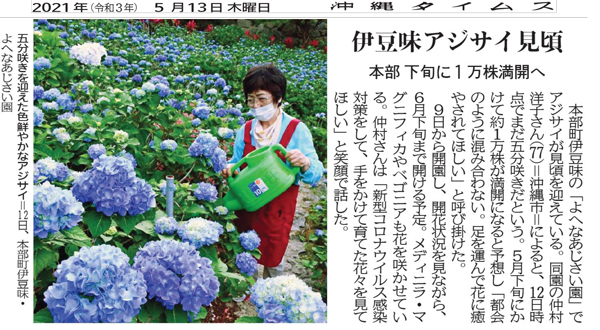
Hydrangeas in full bloom in Izumi, Motobu Town
10,000 plants will be in full bloom by late May
May 13, 2021 (Courtesy of Okinawa Times)
Hydrangeas are in full bloom at the Yohena Hydrangea Garden in Izumi, Motobu Town. According to Ms. Yoko Nakamura, 77, a resident of Okinawa City, the garden is still in half bloom as of May 12th. She expects about 10,000 plants to be in full bloom by the end of May and adds, “It is not crowded like in the city. I hope people will visit the park and relax, enjoying looking at the flowers."
The park will open on the 9th and will remain open until the end of June, depending on how long the flowers remain in bloom. Medinilla magnifica and begonia are also in bloom. Ms. Nakamura said, with a smile, “I want everyone to see the flowers that they have worked so hard to grow, but when you visit here, please take precautions against the new coronavirus infection.”
(Reported by Manabu Tamaki)
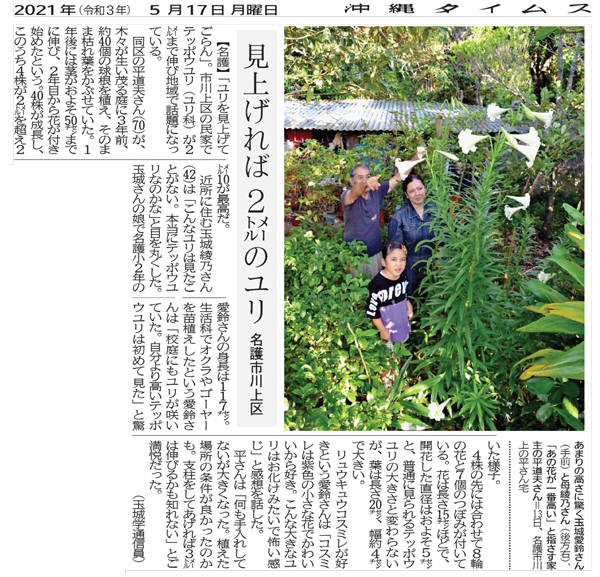
Look up, and You will See 2-Meter Tall Lilies in Kawakami-ku, Nago City
May 17, 2021 (Courtesy of Okinawa Times)
“Look up at these lilies!” A Teppoyuri, Easter lily (Liliaceae) has grown to two meters in height at a private home in Kawakami ward, Nago City, and has become a topic of conversation in the community. According to Mr. Michio Taira, 70, who lives in Kawakami, he planted about 40 bulbs three years ago at his garden full of trees, and covered the lilies with dead leaves. They grew about 50cm in a year, and two years ago started to bloom. All the 40 bulbs grew and among them four plants grew 2m tall, and one of them, the tallest, is 2m 10cm.
Ms. Ayano Tamaki (42), who lives nearby, was surprised to see it. “I have never seen a lily this tall," she remarked. "Is this really Easter Lily?” Her daughter, Airin, who is in the second grade of Nago Elementary School, is 117cm tall and has planted okura and bitter melon seedlings at school as a part of their life environment class. She said, “Easter lilies were blooming in our schoolyard too, but I had never seen a lily that was taller than me. I was so surprised.”
The four plants have a total of eight flowers and seven buds on the ends. The flowers are about 15cm long and the diameter of the blossoms is about 5cm, which is about the same size as a usual lily, but the leaves are very large, 20cm long and 4cm wide. Airin , who likes Ryukyukosumire, Viola yedoensis, said, “I like kosumires because of their cute little purple flowers. But a lily this big is kind of scary, like a ghost. “
Mr. Taira was very delighted. “I haven’t taken any special care of it so far," he said, "but it has grown so big. I think the conditions where I planted it were good. If I prop it up now, I think it will probably grow another 3cm."
(Reported by Manabu Tamaki)
Photo captions:
Airin Tamaki (foreground) and her mother Ayano (on the right in back) are surprised at the height of the Easter Lily.
Michio Taira, the owner of the house, points out that “That flower is the tallest.”
Mr. Taira’s house in Kawakami, Nago City, on May 13.
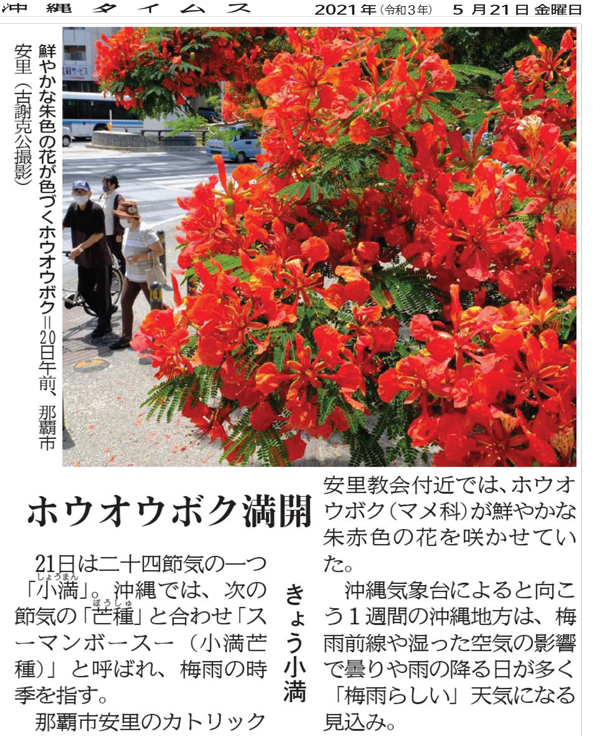
The Royal poinciana is in full bloom
Today is Shoman
May 21, 2021 (Courtesy of Okinawa Times)
May 21 is “Shoman,” one of the twenty-four solar terms. In Okinawa this is combined with the next solar term, “Boshu,” as the term “Suman Bosu," which is the word for the rainy season. In the vicinity of the Catholic Asato Church in Asato, Naha City, the bright vermillion-red flowers of the Royal poinciana are in full bloom.
According to the Okinawa Meteorological Observatory, the weather in Okinawa area over the next week is expected to be cloudy and rainy, typical of the rainy season, due to the rainy season front and moist air.
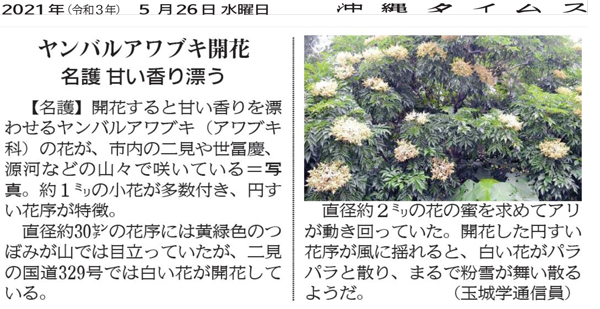
Yanbaruawabuki (Meliosma oldhamil) blooms in Nago, sweet fragrance in the air
May 26, 2021 (Courtesy of Okinawa Times)
The flowers of the Yanbaruawabuki, Meliosma oldhamil (Sabiaceae family), which give off a sweet fragrance when they bloom, are blooming in the mountains of Futami, Yofuke and Genka in Nago City. (See the photo.) They feature a conical inflorescence with many tiny flowers of about 1mm. In the mountains, yellow-green buds on inflorescences about 30 cm in diameter stand out, but along Route 329 in Futami, it is white flowers that are in bloom.
Ants were seen moving around the tiny 2mm diameter flowers in search of nectar.
When the flowering conical inflorescences sway in the wind, the tiny flowers scatter, looking just like a powdery snowfall.
(Reported by Manabu Tamaki)
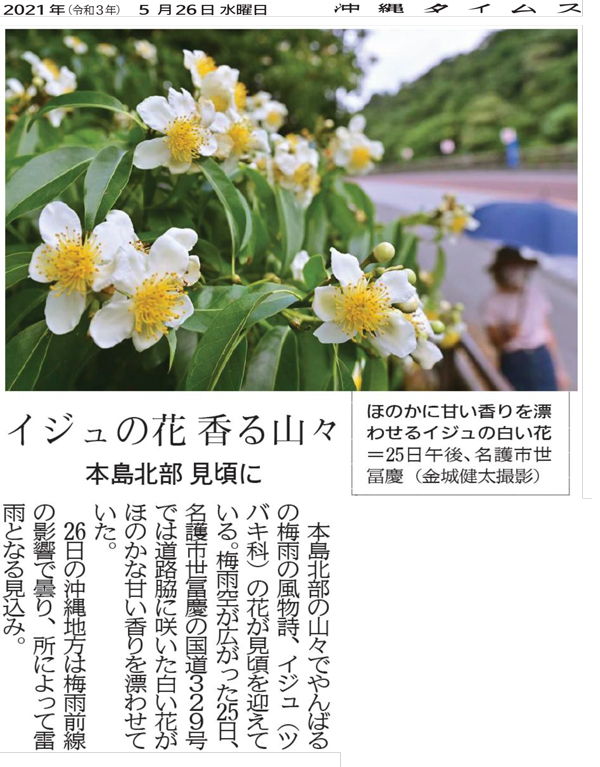
Fragrant Iju Flowers in the Mountains of Northern Part of Main Island
Now is the Best Time to View Them
May 26, 2021 (Courtesy of Okinawa Times)
In the mountains of the northern part of the main island of Okinawa, an area known as Yanbaru, Iju flowers (Camellia family), a typical rainy season flower are now in full bloom. On the 25th, under the rainy season sky, white flowers blooming on the side of the road on Route 329 in Yofuke, Nago City, gave off a faint, sweet fragrance. On the 26th, it is expected that the Okinawa region will be cloudy, with scattered thunderstorms, due to the rainy season front.
The white flowers of the Iju, a tree with a faintly sweet fragrance, at Yofuke, Nago City.
(Photo by Kenta Kinjo)
(June 8, 2021)
Editor’s Picks
-

#196 The Steadily Evolving EM Nature Farming Method at the Blue Sky Palace - Part 6 -

#195 The Steadily Evolving EM Nature Farming Method at the Blue Sky Palace - Part 5 -

#191 Steadily Evolving EM Nature Farming Method at the Blue Sky Palace -

#190 Quantum Mechanical Effects of EM Gravitron Charcoal
- 2025
- Sep:#209 The Widespread Use of EM in Ecuador
- Sep:#208 The Widespread Use of EM in Chile
- Jul:#207 Peru, where EM has taken root throughout the country
- May:#206 EM Application Technology in Paraguay Begins to Evolve into Advanced Circular Agriculture
- May:#205 Practical Application of Soil Disinfectant-Free Cultivation Using EM Technology
- Apr:#204 How EM Use Has Spread Throughout the Philippines
- Mar:#203 How to Use EM to Fundamentally Solve the Problem of Agricultural Residue Burning
- Feb:#202 The Spread of EM technology in Germany
- Jan:#201 The 2nd Ichiro Masaki Memorial Universal Village EM International Conference
- Jan:#200 Cleanup of the Ala Wai Canal in Hawaii, where social bonds are strengthened using EM
- 2024
- Nov:#199 EM trials in India with bananas, tomatoes, and pomegranates
- Oct:#198 The Steadily Evolving EM Nature Farming Method at the Blue Sky Palace - Part 8
- Sep:#197 The Steadily Evolving EM Nature Farming Method at the Blue Sky Palace - Part 7
- Aug:#196 The Steadily Evolving EM Nature Farming Method at the Blue Sky Palace - Part 6
- Jul:#195 The Steadily Evolving EM Nature Farming Method at the Blue Sky Palace - Part 5
- Jun:#194 Steadily Evolving EM Nature Farming Method at the Blue Sky Palace - Part 4
- May:#193 Steadily Evolving EM Nature Farming Method at the Blue Sky Palace - Part 3
- May:#192 Steadily Evolving EM Nature Farming Method at the Blue Sky Palace - Part 2
- Apr:#191 Steadily Evolving EM Nature Farming Method at the Blue Sky Palace
- Mar:#190 Quantum Mechanical Effects of EM Gravitron Charcoal
- Mar:#189 The barrier space in Okinawa (Ryukyu Islands) has risen to another dimension
- Jan:#188 Sixty Days after Typhoon No.6
- 2023
- Oct:#187 Supermassive Typhoon No.6 and Subsequent Typhoon No. 11
- Sep:#186 Massive Typhoon No.6 that swallowed the Ryukyu Islands Graviton barrier
- Sep:#185 August 8th is World “EM Mudball Day”
- Aug:#184 A disease-free life depends on the health of the intestinal microbiome.
- Jul:#183 Trial and Error at the Blue-Sky Palace, Part 3
- Jun:#182 Trial and Error at the Blue-Sky Palace, Part 2
- Apr:#181 Trial and Error at the Blue-Sky Palace
- Mar:#180 Ala Wai Canal Cleanup Project in Waikiki, Hawaii
- Feb:#179 High-Yield, High-Quality Rice Production Using EM
- Feb:#178 The Progress the "Soil Preparation Workshop" of the Oishi 3-chan Club (Part 2)
- Jan:#177 Organic Farming Instructional Manual Using EM
- 2022
- Nov:#176 The Typhoon Situation in Okinawa in 2022
- Sep:#175 Third-Party Verification of the Graviton barrier in Okinawa Part-2
- Sep:#174 Third-Party Verification of the Graviton barrier in Okinawa
- Aug:#173 Ecosystem Changes Observed in Okinawa in 2021 Part-5
- Jun:#172 Ecosystem Changes Observed in Okinawa in 2021 Part-4
- May:#171 Ecosystem Changes Observed in Okinawa in 2021 Part-3
- Apr:#170 Ecosystem Changes Observed in Okinawa in 2021 Part-2
- Mar:#169 Koizumi Farm in Kamakura Continues to Evolve
- Feb:#168 Ecosystem Changes Observed in Okinawa in 2021 Part-1
- 2021
- Dec:#167 Enjoying EM Technology While Enriching the Local Ecosystem
- Nov:#166 A Case Study of the Use of EM in a Next Generation Free School in Tune with the Cycles of Nature
- Oct:#165 Typhoon conditions and flowers in Okinawa from August to October
- Sep:#164 Re-learning the origins of river purification using EM Cleaning up the Dairyuji River in Senami (Murakami City, Niigata Prefecture)
- Aug:#163 Measures Against Natural Disasters and Re-learning the Starting Point of EM
- Jul:#162 Summary of FFC (Foods for Children) Okinawa Forum 2021
- Jun:#161 Restoring the Vigor of an Old Tree and Purifying the Environment with EM Technology That Even an Amateur Can Do
- May:#160 The Public is Beginning to Recognize the Use of EM Smokeless Carbonizers
- Apr:#159 EM Hado (EM Graviton) that exerts quantum superposition effect over time
- Mar:#158 Virus-free Okinawan Plants Through Use of an EM Graviton Barrier
- Jan:#157 Enjoyable Farming for Self-Sufficiency that Even Amateurs Can Do
- 2020
- Dec:#156 EM quantum energy effect occurring in Okinawa
- Nov:#155 Implementing EM graviton farming as a flood countermeasure for apple orchards
- Oct:#154 The Latest Book on the Practical Uses of EM "You Are the One Who Draws Out the Power of Microorganisms," by Chizuko Nomoto
- Sep:#153 Application of EM technology to long periods of rain, lack of sunshine, storms, heavy rains, etc.
- Aug:#152 EM application in Kitanakagusuku village plant waste recycling yard
- Jul:#151 Natural Disaster Countermeasures Using EM Technology: Part 2
- Jul:#150 Natural Disaster Countermeasures Using EM Technology
- May:#149 How to make your home and workplace an energy spot by living a complete EM lifestyle: creating the ultimate source of health and environmental purification
- Apr:#148 EM, Viruses and the Pandemic
- Apr:#147 New agriculture applying quantum mechanics Part 2
- Apr:#146 New agriculture applying quantum mechanics
- Apr:#145 Wonderful EM Miracle
- 2019
- Nov:#144 The movie “Revival II” and the reality of Fukushima
- Oct:#143 Boundary dome and foliar spraying of EM・X GOLD and EM 3
- Oct:#142 Kirakira (Sparkling) Summer Vegetable Festa in 2019
- Aug:#141 Excessive salt inevitably causes salt damage
- Jul:#140 Diverse applications of charcoal Part 3
- Jun:#139 Diverse applications of charcoal Part 2
- Jun:#138 Diverse applications of charcoal
- Jun:#137 Purification power of salt
- May:#136 The degree of soil contamination is a reflection of the microflora
- May:#135 Definitive use of EM barriers to deal with typhoons
- May:#134 Implementing authentic Nature Farming
- May:#133 How to enhance healthy Hado (wave energy) by EM
- May:#132 Eating Dirt (Soil)
- May:#131 Hado (Wave energy) involved in health
- May:#130 Reaffirming EM technology to realize the essence of agriculture
- May:#129 The 2nd EM Producer Networking Meeting
- Apr:#128 Understanding the application of seawater and salt in crop cultivation
- Apr:#127 Prevention of Disasters by EM Technology
- Mar:#126 Quantum overlay effective utilization of EM
- Jan:#125 EM Disaster Recovery Support Projects in 2017
- 2018
- 2017
- Aug:#121 Escape from conventional agricultural traps
- Jul:#120 Limitation and important caveats regarding utilization of salt
- Jun:#119 EM Technology to Break Through the Limits of Pesticide-Free Strawberries
- May:#118 Application of barriers using EM rectification force
- Apr:#117 The 1st EM Produce Growers' Networking Conference
- Mar:#116 Sumizo kun: The Ultimate Versatile Carbonization Equipment
- Feb:#115 How to make and use simple carbonized and rectified ash
- Jan:#114 Achievements of 2016
- 2016
- Dec:#113 Definitive Measures Against Typhoons
- Nov:#112 International Conference on Universal Village
- Oct:#111 90% of Your Body is Microbes
- Sep:#110 Disaster Countermeasures Using EM
- Aug:#109: Changes in the Natural Environment by EM Barrier Domes in Okinawa
- Jul:#108: Multi-purpose Utilization of Activated EM with Seawater and Salt
- Jun:#107: Marine Day, when EM Mudballs and Activated EM are Applied Throughout Japan
- May:#106: The Function of EM and Gravitational Waves–Part 3
- Apr:#105: The Function of EM and Gravitational Waves–Part 2
- Feb:#104: The Function of EM and Gravitational Waves
- Feb:#103: The Importance of Phototrophic Bacteria in EM
- 2015
- Dec:#102: Results of Environmental Forum "Utsukushima EM Paradise" 2015
- Nov:#101: Environmental Forum "Utsukushima EM Paradise" 2015
- Oct:#100: A New Phase of Limit Breakthrough Using EM
- Sep:#99: A New Phase of Limit Breakthrough through EM
- Aug:#98: The Tokyo Bay Area Began Creating a Truly Livable Hometown
- Jul:#97: Rectifying Effects of EM
- Jun:#96: Lake Suwa Sousei lecture
- May:#95: In Order to Further Ensure Limit Breakthrough
- Apr:#94: Theatrical Release of the Documentary Film SOSEI-Revival to Enlighten People on the New Possibilities of Microorganisms
- Mar:#93: What Underlies Limit Breakthrough (Part 2)
- Feb:#92: EM Functions to Break Through Limits
- Jan:#91: At the Start of 2015
- 2014
- Dec:#90: Looking Back at 2014
- Nov:#89: Shikoku EM FESTA 2014, Virtuous Circle Conference in Matsuyama, Ehime Prefecture
- Oct:#88: Using EM to Deal with Weather Disasters (Part 2)
- Sep:#87: Current Status of Radioactivity Measures Using EM in Fukushima
- Aug:#86: APNAN (Asia Pacific Natural Agriculture Network) 25th Anniversary Conference in 2014
- Jul:#85: Using EM to Deal with Weather Disasters
- Jun:#84: Substantial Improvement of Soil
- May:#83: The Energy Rectification Force of EM
- Apr:#82: The Annual 18th EM Technology Exchange Meeting and Tohoku Conference in Shichigahama
- Mar:#81: Salmon going upstream in Kitaura (Kasumigaura)
- Feb:#80: The Microbiome Again
- Jan:#79: Inauguration of the Federation of Diet Members Who Use and Apply Effective Microorganisms
- 2013
- Dec:#78: Receiving an Honorary Doctoral Degree from Rajamangala University of Technology in Thailand
- Nov:#77: The Use of EM in School Education in Bhutan
- Oct:#76: Well of Bonding
- Sep:#75: The Background to EM Not Being Employed by Public Institutions to Deal with Radiation
- Aug:#74: Dealing with Disaster: Using EM in Crisis Management
- Jul:#73: EM Events on Ocean Day
- Jun:#72: Using EM to Deal With Heat Stroke and Summer Heat Fatigue
- May:#71: An EM Model Town in Malaysia
- Apr:#70: Steps the Japanese Government is Taking to Deal with Radiation: Are They Really Safe?
- Mar:#69: EM Group Disaster Reconstruction Aid Project in Fukushima
- Feb:#68: EM and Microbiomes (Microbial Flora)
- Jan:#67: A Necessary Evil is Still Evil
- 2012
- Dec:#66: The 17th National EM Technology Exchange Conference / Hokkaido Conference in Sapporo
- Nov:#65: EM Forum 2012 in Okinawa and the Environmental Forum in Fukushima
- Oct:#64: 2012 EM Forum
- Sep:#63: A New Earth Saving Revolution
- Aug:#62: The Asahi Newspaper’s Misguided Reports About EM
- Jul:#61: Using EM in Radioactive Contamination Measures in Fukushima Prefecture
- Jun:#60: The Effects of Using EM to Inhibit the Absorption of Radioactivity as Confirmed in Fukushima
- May:#59: Recovery Support for the Great East Japan Earthquake
- Apr:#58: The Royal Kingdom of Thailand, in which EM Functions as a Set Government Policy
- Mar:#57: Report on the Measures Taken by Kingdom of Thailand Using EM to Deal with Polluted Water
- Feb:#56 EM™ as Part of National Policy in Thailand to Deal with Sanitation Issues Resulting from the Flood of 2011
- Jan:#55 The Law of Syntropy (Revitalization)
- 2011
- Dec:#54 EM Forum 2011
- Nov:#53 Shikoku EM Festa 2011- Zenjunkan no Wa (Virtuous Circle) Tokushima Conference in Naruto -
- Oct:#52 The Mystery of Interim Safety Values for Radioactive Material
- Sep:#51 Successful Radiation Countermeasures Using EM
- Aug:#50 Events on Sea Day in which EM Mud Balls are Thrown into the Water and Activated EM is Applied.
- May:#47 Dealing with the Damage Caused by the Eastern Japan Earthquake
- Apr:#46 Eastern Japan Earthquake
- Mar:#45 The 16th National EM Technology Hokuriku Conference in Fukui
- Feb:#44 More Thoughts on Avian Influenza and Foot-and-Mouth Disease
- Jan:#43 Happy New Year!
- 2010
- Dec:#42 Shikoku EM FESTA 2010・Zenjunkan no wa (Virtuous Circle) Fellowship Conference in Tobe, Ehime Prefecture
- Nov:#41 EM Forum 2010
- Oct:#40: My Thanks to the EM™ Volunteers Who Helped in the Fight Against Foot-and-Mouth Disease in Miyazaki Prefecture
- Sep:#39 International EM Mud Ball Day
- Jul:#37 Poland EM Forum 2010
- Jun:#36 EM Countermeasures Against Foot-and-Mouth Disease
- May:#35 Abnormal Weather
- Apr:#34 EM Activities in Thailand: Finding Solutions to the Challenges Facing the Nation
- Mar:#33 New Developments in the Evolution of EMTM in Thailand
- Feb:#32 Results Starting to Be Seen at the Mikasa Project
- Jan:#31 Towards an EM-Use Society
- 2009
- Dec:#30 EM Summit
- Nov:#29 The System in Penang State in Malaysia that Made the World EMTM Mudball Day a Success
- Oct:#28 The "World EM Mudball Day" in Malaysia
- Sep:#27 Validating EMTM Medicine: Case Study Reports from EM Users 2009. (Part 3)
- Sep:#26 Validating EMTM Medicine: Case Study Reports from EMTM Users 2009. (Part 2)
- Jul:#25 Validating EMTM Medicine: Case Study Reports from EMTM Users 2009. (Part 1)
- Jun:#24 Activities to Disseminate EM-Focused Nature Farming in China
- May:#23 Use of EMTM in Response to Swine Flu
- Apr:#22 Using EM to Solve Public Administrative Costs
- Mar:#21 Reaffirming the Versatility of EM
- Jan:#20 The Beginning of a New Era
- 2008
